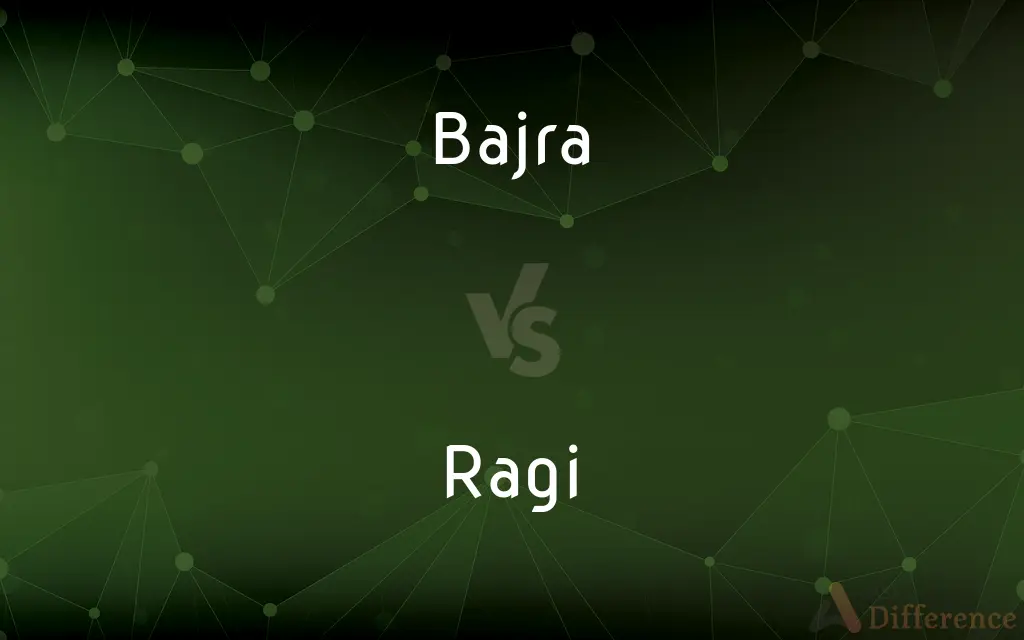Bajra vs. Ragi — What's the Difference?
Edited by Tayyaba Rehman — By Fiza Rafique — Updated on March 21, 2024
Bajra (pearl millet) is a robust, drought-resistant grain known for its high energy content, while ragi (finger millet) is valued for its high calcium content and ability to thrive in arid conditions.

Difference Between Bajra and Ragi
Table of Contents
ADVERTISEMENT
Key Differences
Bajra, or pearl millet, is a staple grain in many arid and semi-arid regions of the world, renowned for its ability to withstand harsh growing conditions. It's a significant source of energy, protein, and fiber, and contains essential minerals such as magnesium, iron, and zinc. Ragi, or finger millet, on the other hand, is especially noted for its high calcium content, making it unique among cereals. It also provides important amino acids, vitamins, and minerals, and is often recommended for infants, the elderly, and those with diabetes due to its low glycemic index.
The cultivation of bajra is widespread in Africa and Asia, reflecting its adaptability to poor soil fertility and drought conditions, which makes it a critical crop for ensuring food security in these regions. Ragi, while also drought-resistant, is primarily grown in the drier parts of Africa and Asia, particularly in India, where it has been cultivated for thousands of years.
In terms of culinary use, bajra is commonly ground into flour and used to make flatbreads, porridge, and other traditional dishes. It has a somewhat nutty flavor. Ragi flour is similarly versatile, used in making breads, pancakes, porridges, and even beverages, and is noted for its slightly sweet taste.
Despite their differences, both grains play a crucial role in sustainable agriculture, thanks to their minimal water requirements compared to more traditional grains like wheat and rice. This aspect, combined with their nutritional benefits, makes bajra and ragi important crops for future food security and for combating malnutrition in drought-prone areas.
Comparison Chart
Primary Nutrient
High in energy, protein, and fiber.
High in calcium and essential amino acids.
ADVERTISEMENT
Adaptability
Thrives in arid and semi-arid regions.
Prefers arid conditions; highly drought-resistant.
Culinary Uses
Used for flatbreads, porridge, and as a cereal.
Used in breads, pancakes, porridges, and beverages.
Flavor
Nutty.
Slightly sweet.
Geographical Spread
Widely cultivated in Africa and Asia.
Mainly grown in parts of Africa and Asia, especially India.
Health Benefits
Aids in digestion, promotes heart health, and is rich in minerals.
Promotes bone health, aids in digestion, and has a low glycemic index.
Significance
Important for food security in drought-prone regions.
Valued for nutritional benefits, especially for infants and the elderly.
Compare with Definitions
Bajra
Known for its adaptability to harsh conditions.
Farmers in arid regions rely on bajra for its resilience to drought.
Ragi
Cultivated in drought-prone areas.
Ragi fields are common in regions where few other crops can survive.
Bajra
A drought-resistant grain high in energy.
Bajra roti is a staple in Indian households, especially in regions with water scarcity.
Ragi
Increasingly recognized for its health benefits.
Ragi is becoming a staple health food in diets around the globe.
Bajra
A versatile ingredient in traditional dishes.
She uses bajra flour to make a variety of nutritious and delicious recipes.
Ragi
Noted for its high calcium content.
Ragi is often recommended for bone health due to its high calcium levels.
Bajra
Nutrient-rich, providing protein and essential minerals.
Incorporating bajra into meals can significantly improve dietary mineral intake.
Ragi
A traditional grain with a sweet flavor.
Ragi porridge is a popular breakfast option because of its slightly sweet taste.
Bajra
Gains global recognition as a superfood.
Due to its health benefits, bajra is gaining popularity as a superfood worldwide.
Ragi
See finger millet.
Bajra
(India) pearl millet (Cenchrus americanus, syn. Pennisetum glaucum)
Ragi
A type of grain, Eleusine coracana, cultivated as a cereal in arid areas of Africa and Asia; finger millet.
Ragi
A type of yeast traditionally used in winemaking, baking, and brewing, now identified as Saccharomyces cerevisiae.
Ragi
East Indian cereal grass whose seed yield a somewhat bitter flour, a staple in the Orient
Common Curiosities
Which is better for weight loss, bajra or ragi?
Both grains are beneficial for weight loss due to their high fiber content; however, ragi's low glycemic index might make it slightly more favorable for controlling appetite and improving metabolism.
Can bajra and ragi be used interchangeably in recipes?
While they can sometimes be substituted for one another, their distinct flavors and textures might affect the outcome of recipes. It's best to adjust recipes according to taste preferences.
Are bajra and ragi gluten-free?
Yes, both bajra and ragi are naturally gluten-free, making them excellent alternatives for those with gluten sensitivities or celiac disease.
Is there any cultural significance attached to bajra and ragi?
Yes, both grains have deep cultural roots in their native regions, being integral to traditional diets and often celebrated in local festivals and culinary traditions.
Which grain is more beneficial for children, bajra or ragi?
Ragi is often recommended for children, especially infants, due to its high calcium content, essential for bone development, and its ease of digestion.
How can bajra and ragi be incorporated into a modern diet?
They can be used in a variety of dishes, from breads and pancakes to smoothies and salads, offering a nutritious alternative to more common grains.
What are the environmental impacts of cultivating bajra and ragi?
Their cultivation has a relatively low environmental impact, requiring fewer resources than many other crops, which makes them valuable for ecological sustainability.
How do the nutritional profiles of bajra and ragi support athletic performance?
The protein and mineral content in bajra, along with the amino acids and energy-providing carbohydrates in ragi, can support muscle recovery and energy needs in athletes.
How do bajra and ragi contribute to sustainable agriculture?
Their low water requirement and adaptability to poor soil conditions make them sustainable choices, particularly in regions vulnerable to climate change and water scarcity.
Can eating bajra or ragi improve skin health?
Yes, the vitamins and minerals in both grains can contribute to healthier skin. Ragi, with its antioxidants, is particularly noted for its skin benefits.
Share Your Discovery

Previous Comparison
Colorway vs. Palette
Next Comparison
Hobby vs. PursuitAuthor Spotlight
Written by
Fiza RafiqueFiza Rafique is a skilled content writer at AskDifference.com, where she meticulously refines and enhances written pieces. Drawing from her vast editorial expertise, Fiza ensures clarity, accuracy, and precision in every article. Passionate about language, she continually seeks to elevate the quality of content for readers worldwide.
Edited by
Tayyaba RehmanTayyaba Rehman is a distinguished writer, currently serving as a primary contributor to askdifference.com. As a researcher in semantics and etymology, Tayyaba's passion for the complexity of languages and their distinctions has found a perfect home on the platform. Tayyaba delves into the intricacies of language, distinguishing between commonly confused words and phrases, thereby providing clarity for readers worldwide.














































